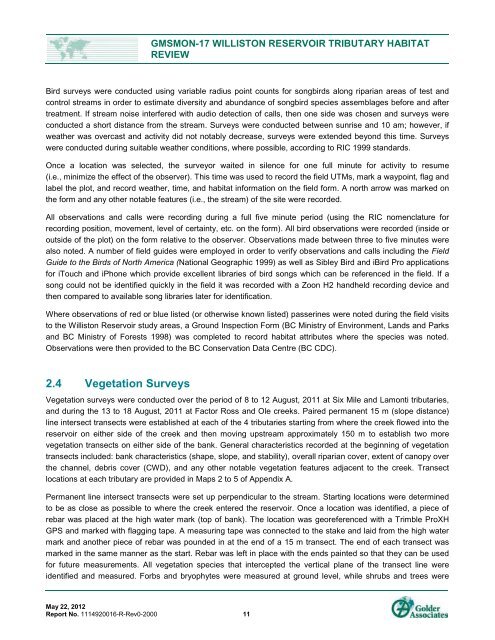GMSMON-17 WILLISTON RESERVOIR TRIBUTARY - BC Hydro
GMSMON-17 WILLISTON RESERVOIR TRIBUTARY - BC Hydro
GMSMON-17 WILLISTON RESERVOIR TRIBUTARY - BC Hydro
Create successful ePaper yourself
Turn your PDF publications into a flip-book with our unique Google optimized e-Paper software.
May 22, 2012<br />
Report No. 1114920016-R-Rev0-2000 11<br />
<strong>GMSMON</strong>-<strong>17</strong> <strong>WILLISTON</strong> <strong>RESERVOIR</strong> <strong>TRIBUTARY</strong> HABITAT<br />
REVIEW<br />
Bird surveys were conducted using variable radius point counts for songbirds along riparian areas of test and<br />
control streams in order to estimate diversity and abundance of songbird species assemblages before and after<br />
treatment. If stream noise interfered with audio detection of calls, then one side was chosen and surveys were<br />
conducted a short distance from the stream. Surveys were conducted between sunrise and 10 am; however, if<br />
weather was overcast and activity did not notably decrease, surveys were extended beyond this time. Surveys<br />
were conducted during suitable weather conditions, where possible, according to RIC 1999 standards.<br />
Once a location was selected, the surveyor waited in silence for one full minute for activity to resume<br />
(i.e., minimize the effect of the observer). This time was used to record the field UTMs, mark a waypoint, flag and<br />
label the plot, and record weather, time, and habitat information on the field form. A north arrow was marked on<br />
the form and any other notable features (i.e., the stream) of the site were recorded.<br />
All observations and calls were recording during a full five minute period (using the RIC nomenclature for<br />
recording position, movement, level of certainty, etc. on the form). All bird observations were recorded (inside or<br />
outside of the plot) on the form relative to the observer. Observations made between three to five minutes were<br />
also noted. A number of field guides were employed in order to verify observations and calls including the Field<br />
Guide to the Birds of North America (National Geographic 1999) as well as Sibley Bird and iBird Pro applications<br />
for iTouch and iPhone which provide excellent libraries of bird songs which can be referenced in the field. If a<br />
song could not be identified quickly in the field it was recorded with a Zoon H2 handheld recording device and<br />
then compared to available song libraries later for identification.<br />
Where observations of red or blue listed (or otherwise known listed) passerines were noted during the field visits<br />
to the Williston Reservoir study areas, a Ground Inspection Form (<strong>BC</strong> Ministry of Environment, Lands and Parks<br />
and <strong>BC</strong> Ministry of Forests 1998) was completed to record habitat attributes where the species was noted.<br />
Observations were then provided to the <strong>BC</strong> Conservation Data Centre (<strong>BC</strong> CDC).<br />
2.4 Vegetation Surveys<br />
Vegetation surveys were conducted over the period of 8 to 12 August, 2011 at Six Mile and Lamonti tributaries,<br />
and during the 13 to 18 August, 2011 at Factor Ross and Ole creeks. Paired permanent 15 m (slope distance)<br />
line intersect transects were established at each of the 4 tributaries starting from where the creek flowed into the<br />
reservoir on either side of the creek and then moving upstream approximately 150 m to establish two more<br />
vegetation transects on either side of the bank. General characteristics recorded at the beginning of vegetation<br />
transects included: bank characteristics (shape, slope, and stability), overall riparian cover, extent of canopy over<br />
the channel, debris cover (CWD), and any other notable vegetation features adjacent to the creek. Transect<br />
locations at each tributary are provided in Maps 2 to 5 of Appendix A.<br />
Permanent line intersect transects were set up perpendicular to the stream. Starting locations were determined<br />
to be as close as possible to where the creek entered the reservoir. Once a location was identified, a piece of<br />
rebar was placed at the high water mark (top of bank). The location was georeferenced with a Trimble ProXH<br />
GPS and marked with flagging tape. A measuring tape was connected to the stake and laid from the high water<br />
mark and another piece of rebar was pounded in at the end of a 15 m transect. The end of each transect was<br />
marked in the same manner as the start. Rebar was left in place with the ends painted so that they can be used<br />
for future measurements. All vegetation species that intercepted the vertical plane of the transect line were<br />
identified and measured. Forbs and bryophytes were measured at ground level, while shrubs and trees were
















